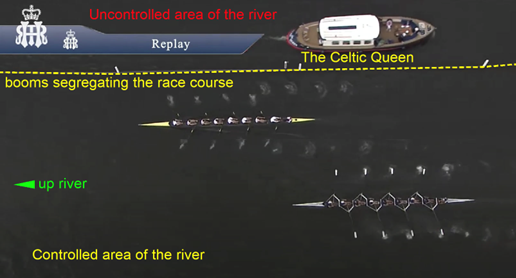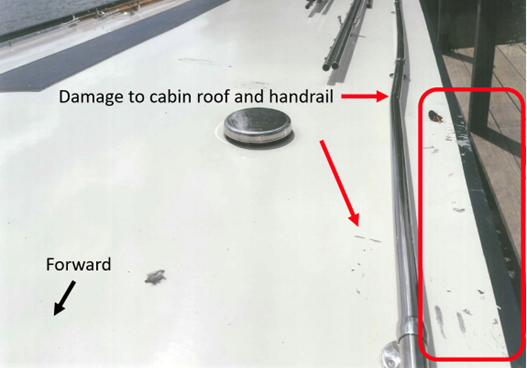The Charity
Aviation
Maritime
DUASxxx8
Initial Report
Commander’s Flying Experience: 831 hours (of which 18 were on type); Last 90 days – 73 hours; Last 28 days – 28 hours
The UAS, a Freefly Systems Inc Alta X, was being operated commercially to provide video footage at the Henley Royal Regatta when a low voltage battery warning occurred in flight at a height of 50m. As the aircraft was being flown back to the landing site, the aircraft battery voltage reduced to the point where controlled flight was lost. It fell, in near free-fall, and impacted a boat on the river, causing damage. No persons were injured. The pilot could not recall checking the aircraft’s battery voltage prior to take-off, and the low voltage battery warning had been changed to trigger at a lower level than that recommended by the manufacturer.

Image from the aircraft, with the Celtic Queen travelling down-river
The risk assessment performed by the operator had identified that a loss of battery power in flight could result in a ‘catastrophic’ outcome and was classified as an ‘unacceptable risk’. However, the operator’s classification reduced this to ‘Low Risk’ when mitigations were applied. These mitigations included checking the battery voltage level prior to take-off. However, the pilot could not recall performing this check.
The aircraft was operating its sixth flight since the batteries had been changed, which was twice that intended by the pilot. He suggested that he may have been fatigued and perhaps the desire to film as many races as possible provided further pressure which may have also distracted him. This may provide possible explanations as to why the aircraft’s batteries were not changed prior to the accident flight as intended by the pilot.
The pilot stated that he would take-off when the battery voltage was less than 48 V, which he considered was acceptable when making short flights. This differed from the manufacturer’s guidance of ‘above 48 V’, although this value was based on the aircraft being operated at its maximum weight. Although, the operator’s risk assessment stated that the pilot and ground crew would monitor battery voltage, neither the camera operator nor observer had been briefed prior to take-off as to what voltage was acceptable. Therefore, neither would have been able to assist the pilot in identifying that the battery voltage was getting low. The manufacturer’s default trigger threshold for the low voltage battery warning was 44 V, and this was also the level at which it recommended that the aircraft should be landed as soon as possible. This warning threshold had been changed by the operator to trigger at 42 V.
Shortly after the low voltage warning had occurred in flight, the battery reached a critical voltage level at which point controlled flight was lost and the aircraft then descended in near free-fall. The aircraft’s kinetic energy when it collided with the boat was estimated to have been about 13,700 Joules. The CASA research paper indicates that fatal injuries would have occurred if the 28 kg aircraft falling at 30 m/s had struck a person on the boat.
Whilst returning to land following a trigger of the low battery voltage warning, the aircraft’s battery voltage depleted to the extent that controlled flight was no longer possible. The aircraft descended, in near free-fall, and impacted an occupied private boat on the river. If the aircraft had struck a person on the boat, it is likely that fatal injuries would have occurred.
The pilot did not replace the aircraft batteries when he had intended to, and a pre-flight check of their voltage before the accident flight was most likely not performed. In addition, the low voltage battery warning had been set to a level below that recommended by the manufacturer. Had the battery warning been set to the manufacturer’s recommended setting, the aircraft may have been landed safely under the pilot’s control.

Damage to the Cabin roof and left side Handrail
CHIRP Comment
This is a surprising report. The pilot was experienced by RPAS standards and had good recency. It is interesting to note however that they had relatively few hours (18) flying the accident aircraft type. We have a few thoughts on the accident:
- It’s never wise to change voltage limits below manufacturers recommended minimum level. They are normally set at a level that has been tested and other limits may have been set accordingly. It therefore follows that other parameters may be impacted, and the pilot may not know which ones have changed and how they have changed. One example of this would be wind gust limits which are set in part by maximum power output calculations.
- On an aircraft system like the Alta, it might be sensible to fix a sticker to the controller with the voltage limit at which return home is necessary, so it is easier to remember, particularly if there is no audible warning mechanism.
- The lack of a briefing for the Observer and Camera Operator. If they had been briefed it might have resulted in one of them calling into question the lack of a voltage check, as part of the pre-flight checks before the accident flight. It sounds like there was time pressure and too much focus on getting the filming done.
- It is always a good idea to bear in mind where you might go at any moment of a flight when an emergency landing becomes your best option. It is easy to speculate on what the outcome might have been if such a site had been the option chosen, rather than trying to get back to base, perhaps involving some acceleration, which simply exacerbated the power problem.
- These sort of operations in proximity to crowds undoubtedly require the granting of an Operational Safety Case approval by the CAA, which implies submitting a comprehensive 3 volume Operations Manual. It may be that the pilot had not refreshed their knowledge of what was contained within the operations manual and it was for this reason a number of its stated requirements for undertaking a flight were not adhered to. A re-read of an Ops manual at regular intervals is always time well spent. It is surprising what you can forget! Volume 3 of the OSC will have all the detail covering the Risk Assessment for an Operation like this where the public is present. It is very important to analyse the severity of the risk which of course can change with the geographical location of the flight. At 28kg flying over the top of crew in the boats racing, who would have been unable to get out of the way of a Drone descending, it was about as severe as you can get.
- The last element we think is also worth bearing in mind, is insurance. As Operations of Drones become more complex and the equipment more costly, there will be a point where insurers, who have perhaps taken a benign approach to paying out when Human Factors have been involved in the past, may have to take a far more robust approach as losses increase. For instance, a situation where an Operator has simply not followed their operations manual and has therefore technically invalidated the terms of their Authorisation, may well lead to insurance cover being withdrawn. Something to perhaps keep in mind for the future.